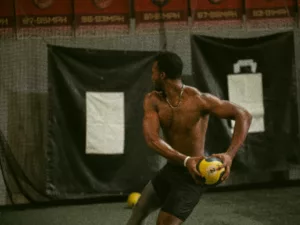 If are you searching for 6 Training Principles of Sports Performance then this is the guide for you!
If are you searching for 6 Training Principles of Sports Performance then this is the guide for you!
Within the complex domain of athletic training, the pursuit of optimal performance relies heavily on comprehension of six fundamental training principles: Specificity, Progression, Overload, Individuality, the Principle of Diminishing Returns, and the Principle of Reversibility. These principles function as a navigational tool for athletes and coaches, providing guidance for the development, execution, and adjustment of training regimens to attain peak performance and overall welfare.
Failure to adhere to or incorrectly implement these principles can result in not only reduced performance but also heightened susceptibility to injury and long-term health complications. This essay provides a deeper analysis of the phenomenon known as detraining, with a specific focus on its negative implications for endurance, strength, power, and bone density. The implementation of tapering is also recognized as a crucial tactic for athletes who are undergoing training for high-level events, thereby completing a thorough and scientifically supported approach to optimizing athletic performance.
#1 Specificity Principle: 6 Training Principles of Sports Performance
 According to Suchomel et al., (2016), the Specificity Principle suggests that training adaptations are contingent upon the specific characteristics of the activity, such as the participating muscle groups and intensity. This notion is of utmost importance in designing training regimens that result in targeted enhancements in performance and physiology. Pollock et al., (2019) argue that specificity plays a crucial role in maximizing performance improvements in aerobic training, such as swimming. This principle emphasizes the need to engage in exercises that closely resemble the actual event. Similarly, when anaerobic exercises such as weightlifting or sprinting, the biomechanical and neuromuscular demands assume crucial significance. According to Haugenet al., (2014), sprinters can derive greater benefits from high-intensity, short-duration training due to its close alignment with the specific needs of sprinting.
According to Suchomel et al., (2016), the Specificity Principle suggests that training adaptations are contingent upon the specific characteristics of the activity, such as the participating muscle groups and intensity. This notion is of utmost importance in designing training regimens that result in targeted enhancements in performance and physiology. Pollock et al., (2019) argue that specificity plays a crucial role in maximizing performance improvements in aerobic training, such as swimming. This principle emphasizes the need to engage in exercises that closely resemble the actual event. Similarly, when anaerobic exercises such as weightlifting or sprinting, the biomechanical and neuromuscular demands assume crucial significance. According to Haugenet al., (2014), sprinters can derive greater benefits from high-intensity, short-duration training due to its close alignment with the specific needs of sprinting.
In baseball and softball, attributes like power, speed, and agility are crucial for player success, enabling athletes to effectively cover the field and react quickly in game-specific situations. This article by Magrini et al., (2018) emphasizes the importance for coaches and strength and conditioning professionals to implement sport-specific drills tailored to baseball or softball. These drills can be conducted either indoors or directly on the field and are designed to enhance players' innate abilities and performance.
#2 Progression Principle: 6 Training Principles of Sports Performance
 The Progression Principle is essential for long-term athletic gains, stipulating that exercise workload must gradually increase for continuous improvement in performance, strength, and endurance (Hoffman, 2014). Its application is universal in aerobic and anaerobic training. Aerobic activities like cycling require a systematic increase in duration, frequency, or intensity to boost cardiovascular health and endurance (Galán-Rioja et al., 2023). In anaerobic exercises such as weightlifting, the focus is on incrementally increasing load or complexity for strength gains and muscle growth (Rauch et al., 2020). However, progression without monitoring can lead to plateaus or overuse injuries (Kellmann et al., 2018). Therefore, a balanced approach using performance evaluations and physiological markers is crucial for sustainable gains and injury prevention (Claudino et al., 2019).
The Progression Principle is essential for long-term athletic gains, stipulating that exercise workload must gradually increase for continuous improvement in performance, strength, and endurance (Hoffman, 2014). Its application is universal in aerobic and anaerobic training. Aerobic activities like cycling require a systematic increase in duration, frequency, or intensity to boost cardiovascular health and endurance (Galán-Rioja et al., 2023). In anaerobic exercises such as weightlifting, the focus is on incrementally increasing load or complexity for strength gains and muscle growth (Rauch et al., 2020). However, progression without monitoring can lead to plateaus or overuse injuries (Kellmann et al., 2018). Therefore, a balanced approach using performance evaluations and physiological markers is crucial for sustainable gains and injury prevention (Claudino et al., 2019).
#3 Overload Principle: 6 Training Principles of Sports Performance
 The Overload Principle asserts that for training gains to occur, a greater stimulus than usual must be applied (Hoffman, 2014). It's key for advancements in both endurance and strength. In aerobic training, overload can be achieved by varying intensity, duration, or frequency (Davies et al., 2018). In anaerobic settings, incremental increases in resistance or intensity fulfill the overload criteria (Pareja-Blanco et al., 2017).
The Overload Principle asserts that for training gains to occur, a greater stimulus than usual must be applied (Hoffman, 2014). It's key for advancements in both endurance and strength. In aerobic training, overload can be achieved by varying intensity, duration, or frequency (Davies et al., 2018). In anaerobic settings, incremental increases in resistance or intensity fulfill the overload criteria (Pareja-Blanco et al., 2017).
While the Overload Principle is critical for training adaptations, improper application can result in negative effects such as overtraining and increased injury susceptibility. Overtraining Syndrome presents as symptoms such as persistent weariness, performance decrease, and increased susceptibility to sickness and can arise when adequate rest and recuperation are not included in a training schedule (Kreher, 2016). Furthermore, improper overloading, particularly when not followed by adequate development, might increase the risk of musculoskeletal injuries such as strains and sprains (Soligard et al., 2016). Athletes can ensure they are on a path to continuous progress by understanding and correctly utilizing the Overload Principle, while also taking the essential precautions to avoid overtraining and injuries.
#4 Individuality Principle: 6 Training Principles of Sports Performance
 The Individuality Principle states that training adaptations vary due to factors like age, gender, and genetics (Hoffman, 2014). Personalized programs are crucial for maximizing gains. In aerobic training, variables like cardiovascular capacity and metabolic rate should guide program design (Bacon et al., 2013). For anaerobic training, muscle fiber composition and joint mobility are key considerations.
The Individuality Principle states that training adaptations vary due to factors like age, gender, and genetics (Hoffman, 2014). Personalized programs are crucial for maximizing gains. In aerobic training, variables like cardiovascular capacity and metabolic rate should guide program design (Bacon et al., 2013). For anaerobic training, muscle fiber composition and joint mobility are key considerations.
Failure to adhere to the Individuality Principle can lead to various adverse outcomes, including stagnation in training progress, heightened susceptibility to injuries, and psychological exhaustion. According to Meeusen et al. (2013), the likelihood of overuse injuries and mental tiredness rises when athletes are exposed to generic training regimens that fail to consider their individual psychological requirements. Moreover, the absence of individualization might lead to suboptimal improvements in performance, as athletes may experience either insufficient stimulation or excessive strain on their physical capacities (Kiely, 2018).
#5 Principle of Diminishing Returns
 The Principle of Diminishing Returns suggests that during the early phases of training, significant improvements are typically observed. However, there exists a threshold beyond which the pace of growth begins to diminish. In essence, as the intensity or volume of training increases, the subsequent advantages derived from each increment become progressively lower, eventually leading to a point of physiological plateau (Hoffman, 2014). This idea functions as a prompt to acknowledge that an excessive quantity does not necessarily equate to enhanced outcomes and that a harmonious strategy is imperative to attain sustainable advancements while mitigating potential hazards.
The Principle of Diminishing Returns suggests that during the early phases of training, significant improvements are typically observed. However, there exists a threshold beyond which the pace of growth begins to diminish. In essence, as the intensity or volume of training increases, the subsequent advantages derived from each increment become progressively lower, eventually leading to a point of physiological plateau (Hoffman, 2014). This idea functions as a prompt to acknowledge that an excessive quantity does not necessarily equate to enhanced outcomes and that a harmonious strategy is imperative to attain sustainable advancements while mitigating potential hazards.
In aerobic training like running, progress in VO2 max and endurance eventually slows (Sylta et al., 2016). Similarly, anaerobic gains in muscle mass and power taper off despite increased training (Ralston et al., 2017). Ignoring this principle can result in overtraining, physical injuries, and psychological burnout. Overreaching for continual gains may also demotivate athletes (Rodrigues, 2023).
#6 Principle of Reversibility: 6 Training Principles of Sports Performance
 The Principle of Reversibility states that training gains can be lost during detraining, emphasizing the need for consistent exercise to maintain peak performance (Hoffman, 2014). Detraining affects endurance metrics like VO2 max and reduces muscle mass and bone density (Jones et al., 2016). It is imperative to prioritize the prevention of detraining in athletes, but it is equally important for them to recognize the significance of implementing a tapering phase before to elite contests. Tapering is a strategic approach that entails a deliberate decrease in both the volume and intensity of training, while concurrently sustaining or even elevating the frequency of training sessions. The primary objective of tapering is to mitigate the physiological and psychological stress experienced by athletes, while avoiding any detrimental effects on performance known as reversibility, as outlined by Pritchard et al. (2015). During this specific time frame, the human body undergoes a process of repair and supercompensation, resulting in the attainment of optimal performance levels. According to Pritchard et al. (2016), if an athlete fails to taper appropriately, they may enter a competition in a state of exhaustion, which can have a detrimental impact on their performance.
The Principle of Reversibility states that training gains can be lost during detraining, emphasizing the need for consistent exercise to maintain peak performance (Hoffman, 2014). Detraining affects endurance metrics like VO2 max and reduces muscle mass and bone density (Jones et al., 2016). It is imperative to prioritize the prevention of detraining in athletes, but it is equally important for them to recognize the significance of implementing a tapering phase before to elite contests. Tapering is a strategic approach that entails a deliberate decrease in both the volume and intensity of training, while concurrently sustaining or even elevating the frequency of training sessions. The primary objective of tapering is to mitigate the physiological and psychological stress experienced by athletes, while avoiding any detrimental effects on performance known as reversibility, as outlined by Pritchard et al. (2015). During this specific time frame, the human body undergoes a process of repair and supercompensation, resulting in the attainment of optimal performance levels. According to Pritchard et al. (2016), if an athlete fails to taper appropriately, they may enter a competition in a state of exhaustion, which can have a detrimental impact on their performance.
Conclusion
Understanding the six key training principles of Specificity, Progression, Overload, Individuality, Diminishing Returns, and Reversibility, is essential for peak performance. These principles shape effective training programs and neglecting them can lead to injuries and suboptimal results. Also crucial are the concepts of detraining, which underscores the need for consistent training, and tapering, vital for peak competition performance. Integrating these principles and concepts is the difference between athletic mediocrity and excellence.
How TopVelocity Applies the 6 Training Principles for Optimal Performance Gains
- Specificity - At TopVelocity, we understand the importance of the Specificity Principle. That’s why our 3X Pitching program is laser-focused on the biomechanical and physiological demands of a pitcher. Each training module is specifically designed to enhance the skills and physical attributes that pitchers need most.
- Progression - Our 2X Position Player and 3X Pitching programs incorporate a progressive structure that enables athletes to gradually increase the intensity of their training. This ensures a seamless transition from foundational skills to advanced techniques, allowing for sustained progress.
- Overload - The TopVelocity training regimen employs the Overload Principle by implementing a blend of plyometrics, weightlifting, and drill work. This varied approach ensures that athletes are constantly challenged, encouraging muscle adaptation and skill enhancement.
- Individuality - We recognize that every athlete is unique. Our remote coaching service provides personalized training plans, taking into account each player's strengths, weaknesses, and goals. This individualized approach helps athletes reach their full potential.
- Principle of Diminishing Returns - TopVelocity’s programs are rooted in the understanding that an athlete’s performance gains decrease over time when training variables remain constant. Hence, our programs employ dynamic periodization to continually challenge the athletes, ensuring that they don't hit a plateau.
- Reversibility - Our GFT Hitting program emphasizes the importance of consistent training to counteract the effects of detraining. We provide structured off-season and in-season training modules to make sure you don't lose the hard-earned gains.
TopVelocity Patreon
If you're committed to elevating your game and optimizing your performance, there's no better time than now to join our community. By signing up for the TopVelocity Patreon, you’ll gain exclusive access to premium content, beginner training modules, remote coaching services, and weekly video analysis. Don't miss your chance to train smarter and play better. Take the first step towards becoming an elite athlete today!
👉 Join us now at TopVelocity.net/patreon 👈
With TopVelocity, you're not just training; you're making an investment in your future as an elite athlete.
References
Bacon, A. P., Carter, R. E., Ogle, E. A., & Joyner, M. J. (2013). VO2max trainability and high intensity interval training in humans: a meta-analysis. PloS one, 8(9), e73182.
Claudino, J. G., Gabbett, T. J., Bourgeois, F., Souza, H. S., Miranda, R. C., Mezêncio, B., ... & Serrão, J. C. (2019). Crossfit overview: Systematic review and meta-analysis. Sports Medicine - Open, 5(1), 1-15.
Davies, R. W., Carson, B. P., & Jakeman, P. M. (2018). Sex differences in the temporal recovery of neuromuscular function following resistance training in resistance trained men and women 18 to 35 years. Frontiers in physiology, 9, 1480.
Galán-Rioja, M. Á., Gonzalez-Ravé, J. M., González-Mohíno, F., & Seiler, S. (2023). Training
Periodization, Intensity Distribution, and Volume in Trained Cyclists: A Systematic Review. International Journal of Sports Physiology and Performance, 1(aop), 1-11.
Gomez-Cabello, A., Ara, I., Gonzalez-Aguero, A., Casajus, J. A., & Vicente-Rodriguez, G. (2012). Effects of training on bone mass in older adults. Sports Medicine, 42(4), 301-325.
Haugen, T. A., Tønnessen, E., Hisdal, J., & Seiler, S. (2014). The role and development of sprinting speed in soccer. International journal of sports physiology and performance, 9(3), 432-441.
Hoffman, J. (2014). Physiological aspects of sport training and performance. Human Kinetics.
Jones, T. W., Smith, A., Macnaughton, L. S., & French, D. N. (2016). Strength and conditioning and concurrent training practices in elite rugby union. The Journal of Strength & Conditioning Research, 30(12), 3354-3366.
Kellmann, M., Bertollo, M., Bosquet, L., Brink, M., Coutts, A. J., Duffield, R., ... & Hecksteden, (2018). Recovery and performance in sport: Consensus statement. International Journal of Sports Physiology and Performance, 13(2), 240-245.
Kiely, J. (2018). Periodization theory: confronting an inconvenient truth. Sports Medicine, 48(4), 753-764.
Kreher, J. B. (2016). Diagnosis and prevention of overtraining syndrome: an opinion on education strategies. Open access journal of sports medicine, 115-122.
Magrini, M., Dawes, J. J., Spaniol, F. J., & Roberts, A. (2018). Speed and agility training for baseball/softball. Strength & Conditioning Journal, 40(1), 68-74.
Meeusen, R., Duclos, M., Foster, C., Fry, A., Gleeson, M., Nieman, D., ... & Urhausen, A. (2013). Prevention, diagnosis, and treatment of the overtraining syndrome: joint consensus statement of the European College of Sport Science and the American College of Sports Medicine. Medicine and science in sports and exercise, 45(1), 186-205.
Pareja‐Blanco, F., Rodríguez‐Rosell, D., Sánchez‐Medina, L., Sanchis‐Moysi, J., Dorado, C., Mora‐Custodio, R., ... & González‐Badillo, J. J. (2017). Effects of velocity loss during resistance training on athletic performance, strength gains and muscle adaptations. Scandinavian journal of medicine & science in sports, 27(7), 724-735.
Pollock, S., Gaoua, N., Johnston, M. J., Cooke, K., Girard, O., & Mileva, K. N. (2019). Training regimes and recovery monitoring practices of elite British swimmers. Journal of sports science & medicine, 18(3), 577.
Pritchard, H., Keogh, J., Barnes, M., & McGuigan, M. (2015). Effects and mechanisms of tapering in maximizing muscular strength. Strength & Conditioning Journal, 37(2), 72-83.
Pritchard, H. J., Tod, D. A., Barnes, M. J., Keogh, J. W., & McGuigan, M. R. (2016). Tapering practices of New Zealand's elite raw powerlifters. Journal of strength and conditioning research, 30(7), 1796-1804.
Ralston, G. W., Kilgore, L., Wyatt, F. B., & Baker, J. S. (2017). The effect of weekly set volume on strength gain: a meta-analysis. Sports Medicine, 47, 2585-2601.
Rauch, J. T., Ugrinowitsch, C., Barakat, C. I., Alvarez, M. R., Brummert, D. L., Aube, D. W., ... & De Souza, E. O. (2020). Auto-regulated exercise selection training regimen produces small increases in lean body mass and maximal strength adaptations in strength-trained individuals. The Journal of Strength & Conditioning Research, 34(4), 1133-1140.
Rodrigues, F., Monteiro, D., Ferraz, R., Branquinho, L., & Forte, P. (2023). The Association between Training Frequency, Symptoms of Overtraining and Injuries in Young Men Soccer Players. International Journal of Environmental Research and Public Health, 20(8), 5466.
Soligard, T., Schwellnus, M., Alonso, J. M., Bahr, R., Clarsen, B., Dijkstra, H. P., ... & Engebretsen, L. (2016). How much is too much? (Part 1) International Olympic Committee consensus statement on load in sport and risk of injury. British journal of sports medicine, 50(17), 1030-1041.
Suchomel, T. J., Nimphius, S., & Stone, M. H. (2016). The importance of muscular strength in athletic performance. Sports Medicine, 46(10), 1419-1449.
Sylta, Ø., Tønnessen, E., Hammarström, D., Danielsen, J., Skovereng, K., Ravn, T., ... & Seiler, (2016). The effect of different high-intensity periodization models on endurance adaptations.



